Since a redesign for the 2011 model year, the Hyundai Elantra has been one of the best-selling compact cars thanks to a combination of dramatic styling, extensive features, good fuel economy, and a relatively low price. Still, I'm not a big fan of the sedan, as it neither rides nor handles well. But what about the Elantra GT hatchback? Based on the European-market Hyundai i30, it's not just an Elantra sedan with a different rear end.
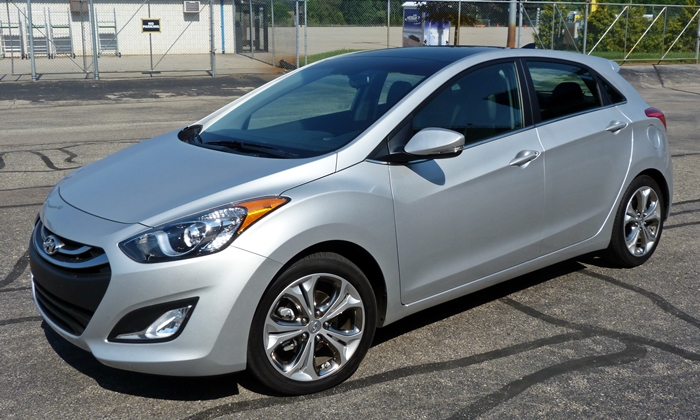
Headlight extends well into fender, undulating body side. Opinions will vary. more Elantra GT photos
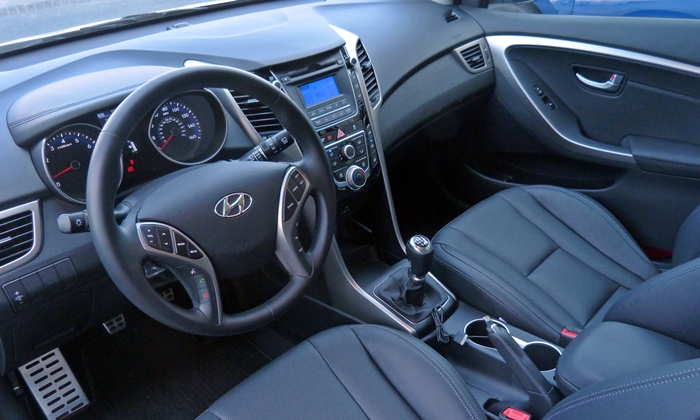
Nice interior, but the Ford's is nicer.
| |
Compared to the Focus |
| Price or payments |
 Better
Worse
Better
Worse
|
Hyundais look and drive much better than they did even five years ago. So it shouldn't come as a surprise that they no longer deeply undercut competitors on price. Still, compared to a Ford Focus (probably its toughest competitor), the #1 reason to buy an Elantra GT remains its price.
Equip both an Elantra GT and a Ford Focus SE with sunroof and heated leather seats, and the Hyundai lists for a significant $1,995 less ($21,920 vs. $23,915). And this is before adjusting for feature differences. Though a Focus SE with Appearance Package is very well equipped, an Elantra GT with Style Package has additional features worth about $1,400 (a "Blue Link" telematics system, dual-panel rather than single-panel sunroof, power instead of manual seat adjustments for lumbar support and recline, driver-side knee airbag, "comfort" vs. "sport" calibration selector). After this adjustment, the Elantra GT is nearly $2,900 less.
Compared to a Mazda3 i Grand Touring, the Hyundai is $2,175 less before adjusting for feature differences and about $1,950 less afterwards.
| Warranty, maintenance cost |
 Better
Worse
Better
Worse
|
Still not adjusted for: Hyundai's famous warranty, 5/60 vs. Ford's and Mazda's 3/36 "bumper-to-bumper" (with exclusions in the fine print--read it) and 10/100 (original owner only) vs. the others' 5/60 on the powertrain.
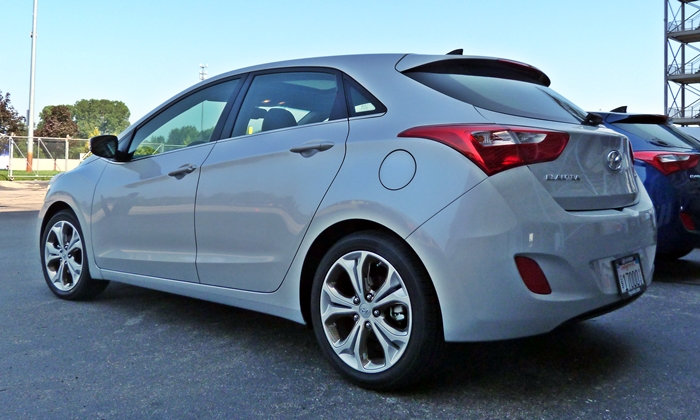
Also dramatic from this angle.
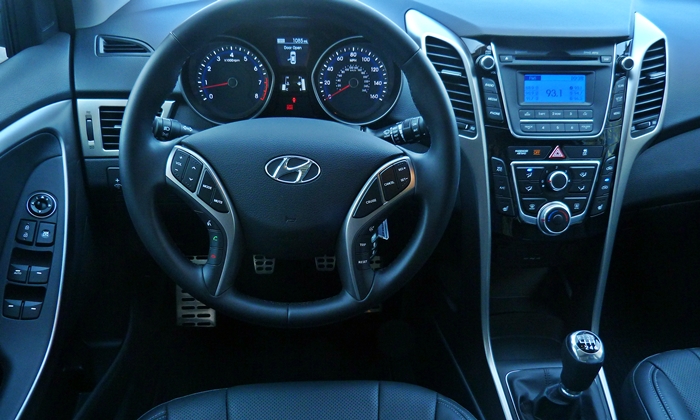
More complicated than the Elantra Touring's, but most buttons are large and within easy reach.
| Exterior styling |
 Better
Worse
Better
Worse
|
I was a big fan of the Hyundai's predecessor, the Elantra Touring, because it had outstanding outward visibility, a lot of room for people and cargo, and fairly entertaining handling. Note that styling is absent from this list, as the Touring's exterior was "clean" (if we're being charitable) or "homely" (if we're not). The Elantra GT's styling is far more dramatic, with the brand's large, hexagonal grille, lamps that stretch far into the fenders, and undulating body sides. It looks good to me, especially from the side and rear quarter. (The grille isn't my favorite part.) The Ford Focus is also very stylish, though. Choosing between them on aesthetic grounds will depend on personal tastes. (Some people find both overwrought.) Few people will prefer the looks of the Mazda3 to either, but judging from the new Mazda6 this will change when the compact car is next redesigned.
Inside, the Elantra GT isn't as attractive or well-finished as the Focus, but it's close, and far nicer than many people expect from a Hyundai (or any car with a price in the low 20s). The Mazda3 places a distant third here.
| Fuel economy |
 Better
Worse
Better
Worse
|
Hyundai made the news a few months ago when it had to revise the EPA ratings for many of its cars. To their credit, they acted quickly, and are compensating previous buyers for the difference.
Even with the downward revision, the Elantra GT is rated 26 mpg city (27 with the automatic) and 37 mpg highway. These figures are slightly better than those for the Ford Focus, but slightly worse than those for the Mazda3.
| Rear seat room & comfort |
 Better
Worse
Better
Worse
|
In Europe, the Hyundai i30 is offered in two lengths, a hatch and an estate (the Queen's English for "wagon"). With the Elantra Touring, we got the estate. Perhaps because not enough people bought an Elantra Touring, Hyundai decided we'd readily trade functionality for styling. So with the Elantra GT we get the hatchback. Compared to the Elantra Touring, the Elantra GT's combined legroom shrinks by over three inches and its cargo volume drops from 65 to 51 cubic feet. The rear seat remains roomier than those in the Ford and Mazda and, owing to a healthy height off the floor, more comfortable than most, but adults no longer have room to stretch. Cargo volume is competitive with the other hatches but no longer rivals that of compact crossovers.
| |
Compared to the Focus |
| Powertrain performance |
 Better
Worse
Better
Worse
|
The Elantra GT doesn't share exterior or interior panels with the Elantra sedan, but it does share a buzzy, under-performing, not remotely "GT-worthy" 148-horsepower, 1.8-liter engine. The 2.0-liter engines in the Ford and Mazda don't offer much more peak power (160, 155), but have substantially stronger midranges (peak torque ratings are 131, 146, and 148 pound-feet, respectively) and feel much more adequate, if still less than sporting, in typical driving.
A Hyundai executive promised me that a better engine was on the way. His hints pointed towards a 2.0-liter non-turbo, perhaps the 173-horsepower, 154-pound-feet-of-torque engine offered in the 2014 Kia Forte. This engine cannot arrive too soon.
A B&M-supplied short-throw shifter was among the things that made the Elantra Touring fun to drive. It's absent in the Elantra GT. Perhaps it will return when the engine is upgraded?
| Handling |
 Better
Worse
Better
Worse
|
Partly thanks to Sachs-supplied dampers, the Elantra GT rides and handles considerably better than the Elantra sedan. But it still lags the Ford and Mazda in these areas. The Hyundai's steering has three selectable levels of assist, but even the "sport" level only feels sporty compared to the other two. No level provides the driver with much feedback.
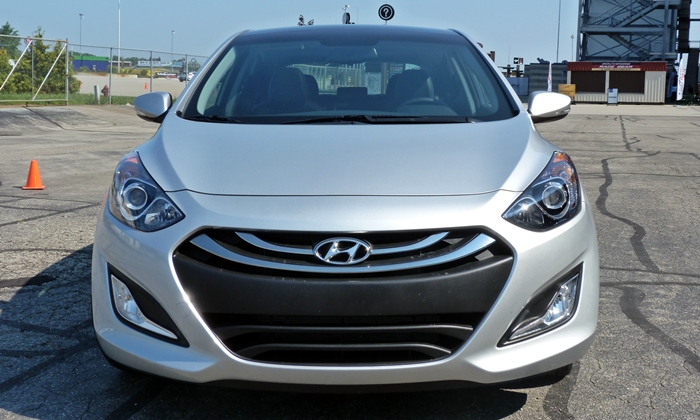
Over-done, over-sized grille not my favorite exterior detail.
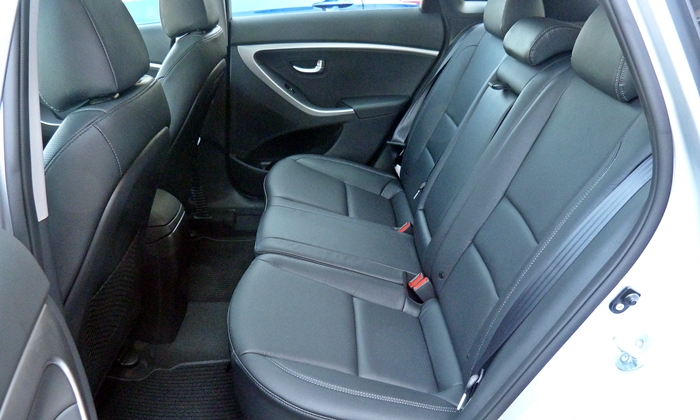
Less legroom than in the Elantra Touring, but still roomier and more comfortable than the average.
| Driving position & visibility |
 Better
Worse
Better
Worse
|
The Elantra GT's swoopy styling has an all-too-common downside. Compared to those in the Elantra Touring, the new car's instrument panel is much deeper (visually distancing the driver from the road) and its windows are smaller. Outward visibility isn't much worse than in the Ford, which in turn isn't much worse than in the Mazda, but I'd (literally) like to see more compact instrument panels and larger windows in all three cars.
The Elantra GT drives better and is more practical than the Elantra sedan. But in 2013 form it is less fun than a Ford Focus or Mazda3, and much less thrilling than any car with a "GT" label ought to be. The Hyundai compensates for this shortcoming with dramatic styling, a longer warranty, and a significantly lower price. Whether this compensation is sufficient depends on your personal tastes and priorities. If you're shopping for a compact hatchback, a test drive will sort this out.
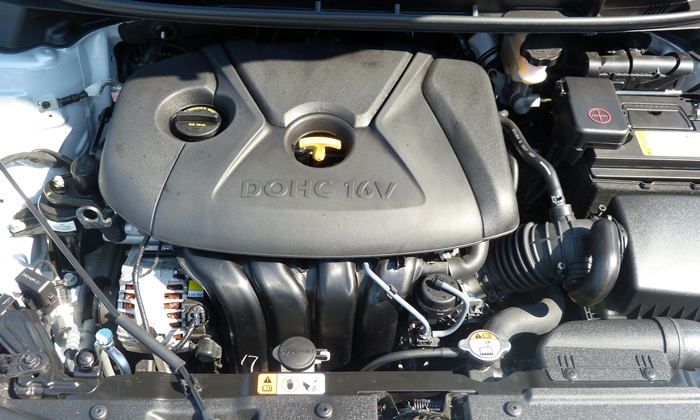
This is the weakest link. Not GT-worthy.
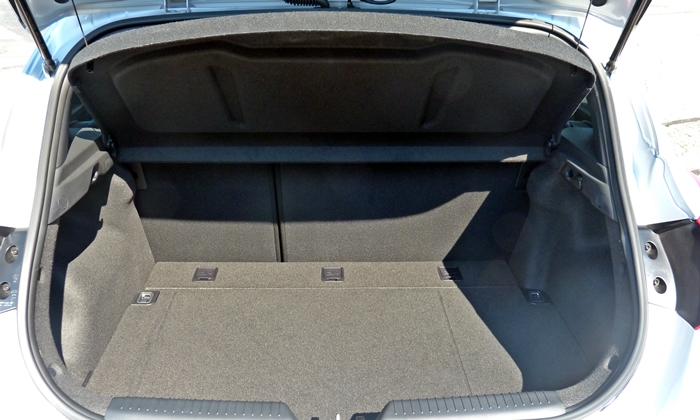
Competitive, with some hidden storage beneath the floor. Much handier than a sedan's trunk.
See more 2013 Hyundai Elantra GT photos
Hyundai provided the car, fuel, insurance, and two meals.











